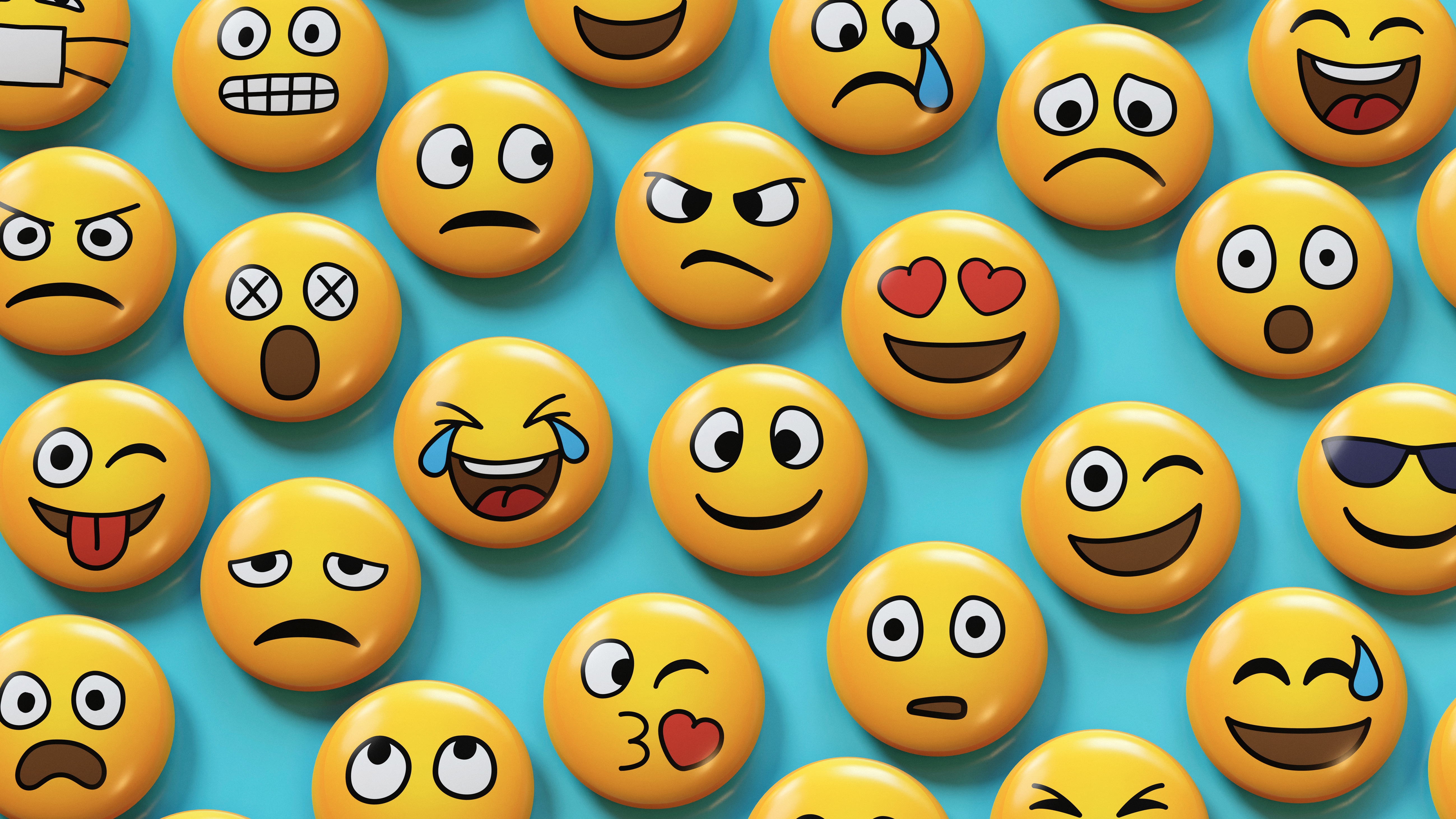Emojis in the workplace can bring colleagues together
Two-thirds of hybrid workers use emojis to feel closer to their colleagues, and this can even lead to a unique workplace language evolving over time


I was today years old when I learned 👀 means you're looking at something. As in, if someone posts a document into a channel, you send 👀 to clarify that you are, indeed, looking at the thing.
I’m not 100% convinced this is correct, admittedly, but it's true according to a survey presented by the workplace collaboration platform Slack and language app Duolingo – released today for Word Emoji Day. I know, there’s literally a day for everything 🙄.
Nevertheless, 9,400 people took part in the poll, representing mobile workers across the US, Asia and Europe. Their interpretations of emoji use in the workplace, and how it contributes to office culture, however, just add more confusion – for me, at least.
For example, the survey found an example of unusual emoji in which an unnamed group of workers deploys a racoon (🦝) when someone’s posted in the wrong channel. I don’t think I’ve ever used the racoon myself, but I’ve definitely posted something in the wrong channel by mistake many, many times. If one of my colleagues replied with '🦝' I’d be confused. I don’t even know what I'd use it for; replying to a racoon picture? Purchasing a racoon? I literally don’t know, but, if I worked at this mystery workplace, I’m sure I'd pick it up quick enough.
This is because emojis are a type of unofficial style guide, tailored and deployed in ways that are specific to the team and the individuals that make it up. ‘Unofficial’ because it's largely unimportant to leadership – they won’t care what you use unless you’re being inappropriate; 🍆, for example, is a potential HR issue, although the survey suggests 56% of Chinese respondents claimed to not know its dual use 🤨.
Within an organisation, the people that make it up will have their favourites, and the more creative types in the team will even create custom ones. Over time, a unique language will evolve. At IT Pro we tend to use the traditional 👍, 🙌 and 👋 mostly. But our idiosyncrasies have given birth to many variations of the party parrot; including ‘beer parrot’, ‘sassy parrot’ and, my favourite, ‘partycage’, which is party parrot melded with the face of Nicolas Cage.
We once had a collection of custom emojis that poked fun at one of our loveable old editors. They depicted him as an ogre and a dinosaur – lovingly – I’m led to believe. What’s more, our newest team member has already added a dancing Ewok– created and added to the database on his first day. In doing so, he’s signalled himself as both a Star Wars nerd and a fun guy – a very welcome addition to the team.
Get the ITPro daily newsletter
Sign up today and you will receive a free copy of our Future Focus 2025 report - the leading guidance on AI, cybersecurity and other IT challenges as per 700+ senior executives
It’s safe to say that emojis are now fundamental and universal communication tool that help us navigate a sea of workplace platforms, and this is largely driven by the use of platforms like Slack, Microsoft Teams and WhatsApp. The survey suggests 53% of respondents use emojis for workplace messages, with 67% saying it makes them feel closer to their colleagues, although 30% say they'd never send an emoji to their boss.
The platform does also appear to be an important aspect, because emoji use isn’t the same through the medium of email. In fact, it could hinder a career path, according to research from Tel Aviv University. Emojis suggest a lack of “power” and may lead to colleagues and bosses thinking less of you, apparently. The first thing to point out here is you probably don’t need to send your colleagues an email, especially if you have instant messaging services. After all, if you only have access to a Gmail account, there’s an instant chat function within that, so stick to it and let the emojis fly.
Bobby Hellard is ITPro's Reviews Editor and has worked on CloudPro and ChannelPro since 2018. In his time at ITPro, Bobby has covered stories for all the major technology companies, such as Apple, Microsoft, Amazon and Facebook, and regularly attends industry-leading events such as AWS Re:Invent and Google Cloud Next.
Bobby mainly covers hardware reviews, but you will also recognize him as the face of many of our video reviews of laptops and smartphones.
-
 Bigger salaries, more burnout: Is the CISO role in crisis?
Bigger salaries, more burnout: Is the CISO role in crisis?In-depth CISOs are more stressed than ever before – but why is this and what can be done?
By Kate O'Flaherty Published
-
 Cheap cyber crime kits can be bought on the dark web for less than $25
Cheap cyber crime kits can be bought on the dark web for less than $25News Research from NordVPN shows phishing kits are now widely available on the dark web and via messaging apps like Telegram, and are often selling for less than $25.
By Emma Woollacott Published
-
 IT professionals aren’t budging on flexible work demands – and more than half say they’ll quit if employers don’t meet expectations
IT professionals aren’t budging on flexible work demands – and more than half say they’ll quit if employers don’t meet expectationsNews Analysis from Randstad shows 40% of UK-based IT pros have quit over a lack of flexible work options, while 31% of workers globally have done the same.
By Ross Kelly Published
-
 'Digital hide-and-seek': Workers are wasting hundreds of hours a year sourcing the information they need to carry out their role
'Digital hide-and-seek': Workers are wasting hundreds of hours a year sourcing the information they need to carry out their roleNews Knowledge workers globally are wasting a quarter of their working week tracking down information, new research from Atlassian has revealed.
By George Fitzmaurice Published
-
 'The tide seems to be turning towards office attendance': 64% of hybrid business leaders want staff back in the office – but many worry that enforcing RTO mandates will drive employees away
'The tide seems to be turning towards office attendance': 64% of hybrid business leaders want staff back in the office – but many worry that enforcing RTO mandates will drive employees awayAnalysis Many UK business leaders want their staff back in the office more frequently, but they’re scared to implement return to office (RTO) mandates in fear of worker revolts.
By George Fitzmaurice Published
-
 Employees are dead set on flexible working arrangements – three quarters would turn down a role that didn't offer hybrid options as work-life balance becomes more important than pay
Employees are dead set on flexible working arrangements – three quarters would turn down a role that didn't offer hybrid options as work-life balance becomes more important than payNews New research shows workers are increasingly demanding flexible working arrangements from employers.
By Emma Woollacott Published
-
 Nearly half of tech workers are seeking new roles – declining employee benefits and reduced flexible working options have staff looking elsewhere
Nearly half of tech workers are seeking new roles – declining employee benefits and reduced flexible working options have staff looking elsewhereNews While salaries are rising for tech workers, other benefits are in decline, leading to a fall in job satisfaction
By Emma Woollacott Published
-
 Untethered: How CIOs and CISOs are paving the way for the new hybrid workforce
Untethered: How CIOs and CISOs are paving the way for the new hybrid workforceWhitepaper Effective techniques to transition from exposed legacy infrastructure to an effective zero trust strategy
By ITPro Published
-
 Unified endpoint management and security in a work-from-anywhere world
Unified endpoint management and security in a work-from-anywhere worldWhitepaper Learn how to converge endpoint management and security processes and systems to drive efficiency and reduce risk
By ITPro Last updated
-
 Unlocking the power of your digital services
Unlocking the power of your digital servicesSponsored Businesses have invested significant cash into technology since COVID-19, but are they really getting their money's worth?
By ITPro Published